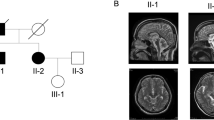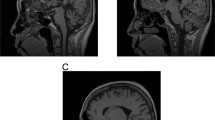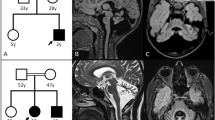Abstract
To date, four families with spinocerebellar ataxia type 5 (SCA5) with four distinct mutations in the spectrin, beta, nonerythrocytic 2 gene (SPTBN2) have been reported worldwide. In the present study, we identified the first Japanese family with SCA5, and analyzed this family clinically and genetically. The clinical features of the five patients in this family revealed late-onset autosomal-dominant pure cerebellar ataxia. We collected DNA samples from the majority of the family members across two generations, and exome sequencing combined with Sanger sequencing revealed a novel heterozygous three-nucleotide in-frame deletion mutation (c.2608_2610delGAG) in exon 14 of the SPTBN2 gene. This mutation cosegregated with the disease in the family and resulted in a glutamic acid deletion (p.E870del) in the sixth spectrin repeat, which is highly conserved in the SPTBN2 gene. This is the first three-nucleotide in-frame deletion mutation in this region of the beta-3 spectrin protein highly likely to be pathogenic based on exome and bioinformatic data.
Similar content being viewed by others
Log in or create a free account to read this content
Gain free access to this article, as well as selected content from this journal and more on nature.com
or
Accession codes
References
Dick, K. A., Ikeda, Y., Day, J. W. & Ranum, L. P. Spinocerebellar ataxia type 5. Handb. Clin. Neurol. 103, 451–459 (2012).
Ikeda, Y., Dick, K. A., Weatherspoon, M. R., Gincel, D., Armbrust, K. R., Dalton, J. C. et al. Spectrin mutations cause spinocerebellar ataxia type 5. Nat. Genet. 38, 184–190 (2006).
Ranum, L. P., Schut, L. J., Lundgren, J. K., Orr, H. T. & Livingston, D. M. Spinocerebellar ataxia type 5 in a family descended from the grandparents of President Lincoln maps to chromosome 11. Nat. Genet. 8, 280–284 (1994).
Stevanin, G., Herman, A., Brice, A. & Dürr, A. Clinical and MRI findings in spinocerebellar ataxia type 5. Neurology 53, 1355–1357 (1999).
Bürk, K., Zühlke, C., König, I. R., Ziegler, A., Schwinger, E., Globas, C. et al. Spinocerebellar ataxia type 5: clinical and molecular genetic features of a German kindred. Neurology 62, 327–329 (2004).
Cho, E. & Fogel, B. L. A family with spinocerebellar ataxia type 5 found to have a novel missense mutation within a SPTBN2 spectrin repeat. Cerebellum 12, 162–164 (2013).
Jacob, F.-D., Ho, E. S., Martinez-Ojeda, M., Darrans, B. T. & Khwaja, O. S. Case of infantile onset spinocerebellar ataxia type 5. J. Child Neurol. 28, 1292–1295 (2012).
Li, H. & Durbin, R. Fast and accurate short read alignment with Burrows-Wheeler transform. Bioinfomatics 38, 1767–1771 (2010).
Sherry, S. T., Ward, M. H., Kholodov, M., Baker, J., Phan, L., Smigielski, E. M. et al. dbSNP: the NCBI database of genetic variation. Nucleic Acids Res. 29, 308–311 (2001).
1000 Genomes Project Consortium. A map of human genome variation from population-scale sequencing. Nature 467, 1061–1073 (2010).
Choi, Y. A fast computation of pairwise sequence alignment scores between a protein and a set of single-locus variants of another protein In Proceedings of the ACM Conference on Bioinformatics, Computational Biology and Biomedicine (BCB ’12) 414–417 (ACM: New York, NY, USA, 2012).
Schwarz, J. M., Rödelsperger, C., Schuelke, M. & Seelow, D. MutationTaster evaluates disease-causing potential of sequence alterations. Nat. Methods 7, 575–576 (2010).
Ylanne, J., Scheffzek, K., Young, P. & Saraste, M. Crystal structure of the alpha-actinin rod reveals an extensive torsional twist. Structure 9, 597–604 (2001).
Lee, Y.-C., Durr, A., Majczenko, K., Huang, Y.-H., Liu, Y.-C., Lien, C.-C. et al. Mutations in KCND3 cause spinocerebellar ataxia type 22. Ann. Neurol. 72, 859–869 (2012).
Bauer, P., Schöls, L. & Riess, O. Spectrin mutations in spinocerebellar ataxia (SCA). Bioessays 28, 785–787 (2006).
Lise, S., Clarkson, Y., Perkins, E., Kwasniewska, A., Sadighi Akha, E., Schnekenberg, R. P. et al. Recessive mutations in SPTBN2 implicate b-III spectrin in both cognitive and motor development. PLoS Genet. 8, e1003074 (2012).
Elsayed, S. M., Heller, R., Thoenes, M., Zaki, M. S., Swan, D., Elsobky, E. et al. Autosomal dominant SCA5 and autosomal recessive infantile SCA are allelic conditions resulting from SPTBN2 mutations. Eur. J. Hum. Genet. 22, 286–288 (2014).
Acknowledgements
We thank the family for participating in this study. We also thank Drs Hayashi and Akiyama, Akiyama Neurosurgery Clinic, for referring the patients to us, and Drs Honda and Shimazaki, Department of Neurology, Jichi Medical University, and Dr Kinya Ishikawa, Department of Neurology and Neurological Science, Graduate School, Tokyo Medical and Dental University, for the molecular testing of the proband for SCA1, SCA2, MJD, SCA6, SCA7, SCA8, SCA12, SCA17, SCA31 and DRPLA. This work was supported by a grant from the Research Committee for Ataxic Diseases (YT) of the Ministry of Health, Labor and Welfare, Japan.
Accession codes The nucleotide sequence data reported are available in the GenBank database under the accession number KJ567653.
Author information
Authors and Affiliations
Corresponding author
Ethics declarations
Competing interests
The authors declare no conflict of interest.
Additional information
Supplementary Information accompanies the paper on Journal of Human Genetics website
Supplementary information
Rights and permissions
About this article
Cite this article
Wang, Y., Koh, K., Miwa, M. et al. A Japanese SCA5 family with a novel three-nucleotide in-frame deletion mutation in the SPTBN2 gene: a clinical and genetic study. J Hum Genet 59, 569–573 (2014). https://doi.org/10.1038/jhg.2014.74
Received:
Revised:
Accepted:
Published:
Issue date:
DOI: https://doi.org/10.1038/jhg.2014.74
This article is cited by
-
Two novel missense variants in SPTBN2 likely associated with spinocerebellar ataxia type 5
Neurological Sciences (2021)
-
Between SCA5 and SCAR14: delineation of the SPTBN2 p.R480W-associated phenotype
European Journal of Human Genetics (2018)
-
A Novel Homozygous Mutation in SPTBN2 Leads to Spinocerebellar Ataxia in a Consanguineous Family: Report of a New Infantile-Onset Case and Brief Review of the Literature
The Cerebellum (2018)
-
A human β-III-spectrin spinocerebellar ataxia type 5 mutation causes high-affinity F-actin binding
Scientific Reports (2016)



